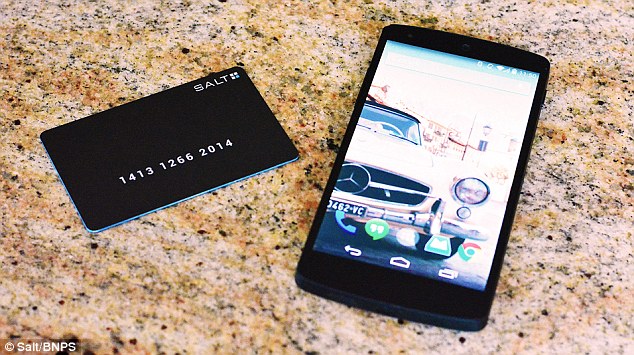CHICAGO (Web Desk) – If you’re fed up with repeatedly typing passwords, hovering your finger on a sensor or staring at your phone waiting for it to scan your face to unlock it, a new device could cure your woes.
The Salt card is designed to end the tiresome task of manually unlocking a smartphone or tablet by automatically making it come to life whenever the user is nearby.
The credit card-sized gadget also locks devices again as soon as a user moves out of range at a distance of 10 feet (three metres).
Salt connects to an app on a user’s Android handset or iPhone via Bluetooth and also tells them if they have strayed too far from their wallet, where the firm suggests the Salt card is stored.
The card was created by Joel Paglione and Niko Zistakis..
They claim it will save people around 53 hours over a year, based on the belief that the average phone user unlocks their phone 150 times a day.
The duo, based in Chicago, Illinois, came up with the idea as an increased method of security and a time-saving device and recently raised more than $82,000 (£53,512) on Kickstarter to put it into production.
The Salt card is made of durable plastic with a matte finish and is the same height and length as an ordinary credit card.
However, it’s three times as thick because it has to be big enough to store the battery, which lasts for 18 months.
Setting up the card is said to be simple, as users only have to enter the unique 12-digit code printed on the front of the card in the iOS or Android app to register it as their own.
From then on, their phone automatically unlocks when they move within 10ft (three metres) of it.
It does this thanks to a Bluetooth chip that emits a low-frequency signal that can be read by the phone, but doesn’t consume the battery, according to the start-up.
“You don’t have to connect it your phone like you normally do with Bluetooth – it basically acts as a beacon and finds your phone, unlocking it,” Mr Paglione said.
The card sends notifications to a user’s phone if they leave their wallet containing the card behind, as well as telling them the last location they had it.
In the future it will be possible to change the proximity needed for the card to unlock the phone.
“So you could set it for 30 feet (9 metres) when you’re in your house so you don’t have to put in your pin at home, but when you’re out you might want it so it only unlocks when the card is in your hand, so you could set it to one foot proximity,” he explained.
The card costs $20 (£13) and can be ordered from the company’s website.
Mr Paglione, 30, said that as well as being tedious, constantly entering a password can be a security issue because criminals can spot a pattern and there are cameras everywhere.
“Many people are looking for additional ways to secure their phone and people are always looking for ways to save time,” he said.
However, it may appear that if a user’s handbag is stolen with their wallet including the card and their phone inside, Salt may prove less secure than a standard password.
Mr Zistakis, an architect by profession, developed a prototype using a Bluetooth headset and then Mr Paglione added his manufacturing expertise to create the product.
He conceded: ‘There are other people doing similar things, but the difference is we have put it into a device that can be hidden away and at $20 it’s very affordable.
‘The card is waterproof, so you could go swimming with it.’
There are already key fobs that can unlock handsets and many people no longer input a PIN, instead using biometric technology, such as fingerprint scanners and face scanners, to unlock their smartphones.













